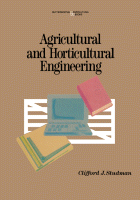Browse content
Table of contents
Actions for selected chapters
- Full text access
- Book chapterNo access
Chapter 1 - The Engineering Approach
Pages 15-24 - Book chapterNo access
Chapter 2 - Surveying
Pages 25-62 - Book chapterNo access
Chapter 3 - Models of our World
Pages 63-110 - Book chapterNo access
Chapter 4 - Workshop methods
Pages 111-124 - Book chapterNo access
Chapter 5 - Hydraulics
Pages 125-209 - Book chapterNo access
Chapter 6 - Electricity and Electronics
Pages 210-247 - Book chapterNo access
Chapter 7 - Power systems and thermal systems
Pages 248-314 - Book chapterNo access
Chapter 8 - Buildings: Materials, Designs and Construction
Pages 315-374 - Book chapterNo access
Chapter 9 - Fencing
Pages 375-416 - Book chapterNo access
Chapter 10 - Milking machines
Pages 417-434 - Book chapterNo access
Chapter 11 - Post harvest systems
Pages 435-448 - Book chapterNo access
Chapter 12 - Our environment, its measurement, destruction and protection
Pages 449-467 - Book chapterNo access
Appendix - Converting Units
Pages 469-472 - Book chapterNo access
Index
Pages 473-500
About the book
Description
Agricultural and Horticultural Engineering: Principles, Models, Systems, and Techniques focuses on the developments in agriculture and horticulture, including the role of engineers in employing measures in the management of plants, animals, and machinery. The book first offers information on the process of surveying, including tape, compass, and aerial surveying, leveling, barometric leveling with the aneroid, plane tabling, and electronic distance measurement and electronic total. The text then takes a look at models of the environment, material properties, and the relationship between stress and strain. The publication examines workshop methods and hydraulics. Topics include soldering, electric arc welding, low temperature brazing, welding using oxygen-acetylene apparatus, hydrodynamics, and water supply requirements. The text also reviews electricity and electronics and power and thermal systems, as well as alternating voltage supplies, electrical motors, electrical safety, power and energy consumption, and the fundamental principles of electronics. The manuscript is a dependable reference for engineers and readers interested in agricultural and horticultural engineering.
Agricultural and Horticultural Engineering: Principles, Models, Systems, and Techniques focuses on the developments in agriculture and horticulture, including the role of engineers in employing measures in the management of plants, animals, and machinery. The book first offers information on the process of surveying, including tape, compass, and aerial surveying, leveling, barometric leveling with the aneroid, plane tabling, and electronic distance measurement and electronic total. The text then takes a look at models of the environment, material properties, and the relationship between stress and strain. The publication examines workshop methods and hydraulics. Topics include soldering, electric arc welding, low temperature brazing, welding using oxygen-acetylene apparatus, hydrodynamics, and water supply requirements. The text also reviews electricity and electronics and power and thermal systems, as well as alternating voltage supplies, electrical motors, electrical safety, power and energy consumption, and the fundamental principles of electronics. The manuscript is a dependable reference for engineers and readers interested in agricultural and horticultural engineering.
Details
ISBN
978-0-409-60469-6
Language
English
Published
1990
Copyright
Copyright © 1990 Elsevier Ltd. All rights reserved.
Imprint
Butterworth-Heinemann
